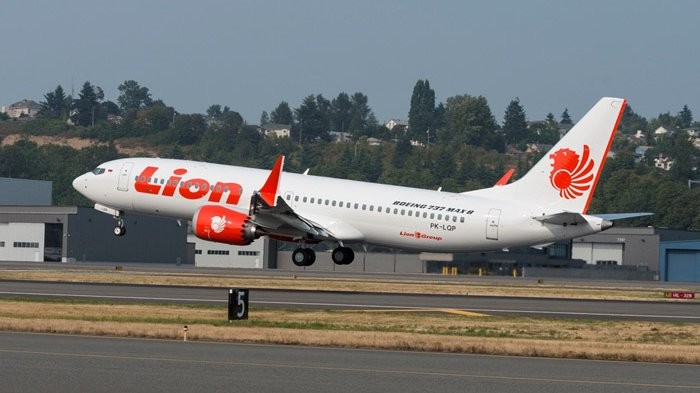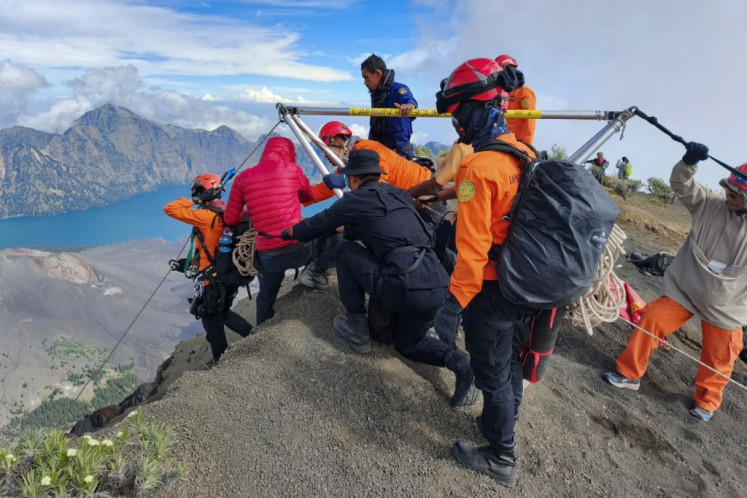Popular Reads
Top Results
Can't find what you're looking for?
View all search resultsPopular Reads
Top Results
Can't find what you're looking for?
View all search resultsLion Air jet's final plunge topped 300 miles per hour, data show
Change text size
Gift Premium Articles
to Anyone
T
he Indonesian airliner that crashed Monday in waters near Jakarta was plunging at hundreds of miles an hour in its final seconds, according to preliminary data transmitted by the plane that could aid investigators looking for a cause.
Lion Air Flight JT610, a nearly new Boeing Co. 737 Max jet, went down from 4,850 feet (1,479 meters) altitude in just 21 seconds, according to data compiled by FlightRadar24, a flight-tracking system. The plane was carrying 189 people and all are feared dead.
A routine descent for an airliner would be about 1,500 to 2,000 feet per minute, said John Cox, the president of the consulting company Safety Operating Systems who has participated in numerous crash investigations. The final data point obtained by FlightRadar24 showed the plane descending at 30,976 feet per minute, meaning it was moving downward at about 350 miles an hour. Such speeds are typical of mid-range flight speeds, but unheard of for a descent.
“This thing really comes unglued,” Cox said. “The numbers are barely believable.”
Lion Air #JT610 summary
Operated by a Boeing 737 MAX 8 registration PK-LQP, delivered in August 2018.
23:20 UTC Take off from Jakarta
23:31 UTC Last signal received at 425 feet AMSL. Vertical speed -30,000 feet/min.
Full data:https://t.co/QCUucGKVHr pic.twitter.com/xSSx0ICaEo
— Flightradar24 (@flightradar24) October 29, 2018
Read also: Distraught families recall JT610 passengers' last words
FlightRadar24’s track of the flight raises as many questions as it answers. It shows the plane rising and climbing repeatedly with the speed also varying, both of which aren’t typical on the latest, computer-driven aircraft. Multiple failures involving the crew and equipment on the plane are possible explanations, from an erroneous speed indication to some sort of electronic failure.
Shortly after takeoff from Jakarta, one of the plane’s pilots requested permission to return to the airport, indicating the crew may have been struggling with some type of failure.
The limited and sometimes contradictory information about the flight doesn’t obviously match any previous accidents, making it difficult to narrow down the possible cause, said Steve Wallace, the former head of accident investigations at the U.S. Federal Aviation Administration.
“I have no most likely scenario in my head for this accident,” Wallace said.
Read also: Lion Air JT610 crash: What we know so far
Cox said the data -- which are generated by the plane’s own systems and transmitted to ground stations -- should be approached with caution at this early stage of the investigation. For example, even in cases when planes plunge to the ground, the descent speed isn’t typically as high as the Lion Air readings, he said.
Still, there’s little doubt that the plane experienced a rapid and violent fall in the final seconds, he said.
Because an aircraft’s speed is measured in multiple ways by overlapping systems on the plane, it won’t be until investigators retrieve the plane’s crash-proof flight recorders that they can determine what happened, he said.
On a newly built plane such as the 737 Max, the plane’s flight recorder will store thousands of parameters of data. Similarly, the cockpit-sound recorder will have the latest digital technology and should be capable of capturing the previous two hours of cockpit activity. The devices also should be relatively easy to find since the plane is in relatively shallow water.
“The flight and voice recorders will be absolutely essential,” Wallace said.










